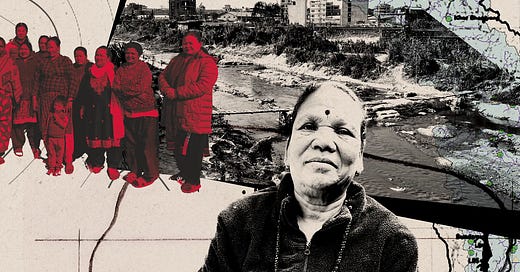Dear friends,
I have a long reported feature in The Baffler’s new issue. It begins like this:
They came in broad daylight, the police and their bulldozers, on the afternoon of November 28, 2022. Their orders were to destroy the makeshift houses and evict the people living on public property along the banks of the Bagmati River in the Thapathali section of Kathmandu. As word spread, the people of this long-established slum community of perhaps a thousand—families with children, poor and landless, many having lived there for decades—grabbed stones, bricks, bamboo poles, and whatever else they could to resist the machinery of the state. Squaring off against hundreds of police where the thoroughfare of Shiva Marg meets the riverbank, they fought in the street—injuring about two dozen police personnel, three seriously, according to the city government.
A decade earlier, in May 2012, the government had sent more than a thousand security personnel and managed to demolish 251 structures in the Thapathali settlement, despite fierce resistance, in an attempt to evict the community by overwhelming force. For the most part, that effort failed. People rebuilt, though the settlement is smaller now. This time, the residents were determined to protect their homes: improvised structures, simple yet dignified, made of cement blocks, plywood, bamboo, sheet plastic, and corrugated metal, crammed together on either side of the settlement’s single, unpaved lane. And this time the police, bruised and bleeding, fell back. The crowd facing them grew, and its ranks swelled with people from other informal settlements who came running to their defense in solidarity, forming barricades with their bodies. The bulldozers retreated, at least for the time being.
The struggle was far from over. …
It’s not clear exactly how many people live in the informal settlements of Kathmandu Valley, but it’s a relatively small number compared with other major cities in South Asia. According to rights advocates, there are fifty-four settlements in the Valley with about five thousand households—perhaps fifty thousand human beings—in a swelling population of up to five or six million. What is clear is that informal settlements along the Bagmati River corridor stand in the way of lucrative riverfront real-estate development, along with a much-touted “beautification” effort known as the Bagmati River Basin Improvement Project, financed by the Asian Development Bank (ADB) and slated for completion this year. Good for nearby property values—in the short run, perhaps.
But what is also clear is that the accelerating impacts of global warming threaten to make much of the Kathmandu Valley unlivable in the coming decades, starting with the areas closest to the rivers. And the ADB-financed development does little if anything to make the Bagmati corridor more resilient, in any significant way, to the ever-more damaging floods—the consequence of more intense and unpredictable extreme downpours in a concrete urban landscape that has overtaken the river’s ancient floodplain. (According to a 2023 study, the area of Kathmandu at high risk of severe flooding will likely double within two or three decades.) In fact, with all the new concrete poured along the river’s banks, the beautification project may have worsened the flooding already.
In any sane—and humane—world, the people in the informal settlements would be given the opportunity to move to higher ground, where they would be provided with safe and secure housing, and the floodplains of the Bagmati and the Kathmandu Valley’s other rivers would be restored as much as possible to make way for and absorb the flood waters. But such adaptation efforts, costly and disruptive, are nowhere to be seen. And what’s happening along the Bagmati River—the struggle between human rights and unchecked, profit-driven growth—is just one aspect of the many-faceted crisis into which Kathmandu and Nepal as a whole are headed, like so many other places in the Global South, as chaotic urbanization, economic and political inequality, and an accelerating climate catastrophe converge. …
-Wen


